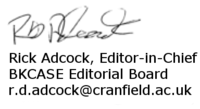Editor's Corner
A very warm welcome to you if you are a returning SEBoK user, and in particular to anyone new to the SEBoK.
I have recently taken the post of Editor in Chief for BKCASE, which includes responsibility for the SEBoK. Many thanks to the BKCASE Governors and the current members of the Editorial Board for their support. Special thanks to the outgoing Editor in Chief Art Pyster and Co-Editor in Chief Dave Olwell, who led the BKCASE efforts from 2009 through the beginning of 2014, and to all the members of the original BKCASE Core Team.
SEBoK v. 1.3
SEBoK v. 1.3 is a minor release which continues our commitment to regular review of the information referenced in our guide to the systems engineering body of knowledge. The primary focus of the Editorial Board for this release was review of references to ensure that they continue to represent the most current information and resources from the systems engineering community. In addition, we have generated a number of new case studies. The primary changes from SEBoK v. 1.2 are:
- A new use case intended to help individuals who are unfamiliar with systems engineering understand key concepts and navigate the SEBoK to get acquainted with the discipline;
- Three new case studies on Business Transformation, Next Generation Air Traffic Control, and NASA's Mission to Saturn;
- Updates to the Hubble Space Telescope Case Study; and
- Updates to references and content to reflect the publication of the newest version of the Project Management Body of Knowledge (PMBoK).
Future Direction for SEBoK
As I take on my new role in BKCASE I have inherited a coree group of deicated and knowledgable contributing authors and reviewers. Some of whom have taken roles on the editorial board while many more remain actively involved in the continuing maintenance and evolution of the SEBoK. Alongside this group we have started the process of expanding our relationships with key organizations and groups both within systems engineering and outside of it.
The role of the Editorial Board is to work with this community of interest on an ongoing review of the current SEBoK content and structure and to develope plans for its maintenance and evolution. Some of the areas under consideration for revision over the next 18 months include:
- General exploration of ways in which we can better cover cross cutting application issues such as model based SE and agile life cycle approaches.
- Review of Part 2 (Systems) with International Society for the Systems Sciences (ISSS) to better understand the relationships amonst Systems Thinking, Systems Science and the Systems Approach as applied to Engineered Systems. We hope this will lead to an improved integration of systems principles, concepts, patterns and models into the other systems engineering focused knowledge areas across the SEBoK.
- Continue with the alignment and co-evolution of Part 3 (Systems Engineering and Management) with other systems engineering life cycle documentation, in particular ISO/IEC/IEEE 15288 and the INCOSE Systems Engineering Handbook, v. 4.0.
- Assess our approach to knowledge on the ways in which systems engineering is applied. This may include expansion of the Service and Enterprise knowledge areas in Part 4 (Applications of Systems Engineering). It will also consider how systems engineering practices such as architecting, life cycle management and model based systems engineering are adressed across the SEBoK.
- Identify the other groups, both within the systems engineering community and beyond, with interest in the topics of Parts 5 and 6 and form stronger relationships with them, e.g. INCOSE Systems Safety working group.
We aim to ensure that our coverage of existing systems engineering knowledge is complete and to push the boundaries of that knowledge into new approaches and domains. I also want to strengthen further our links to all members of the systems engineering community through things like the SEBoK Sandbox. I hope that we can gather review comments and content suggestions from as wide a variety of individuals as possible to make the SEBoK a truly community-led product.
I very much look forward to working with many of you on future SEBoK releases in the future.
Thank you,
